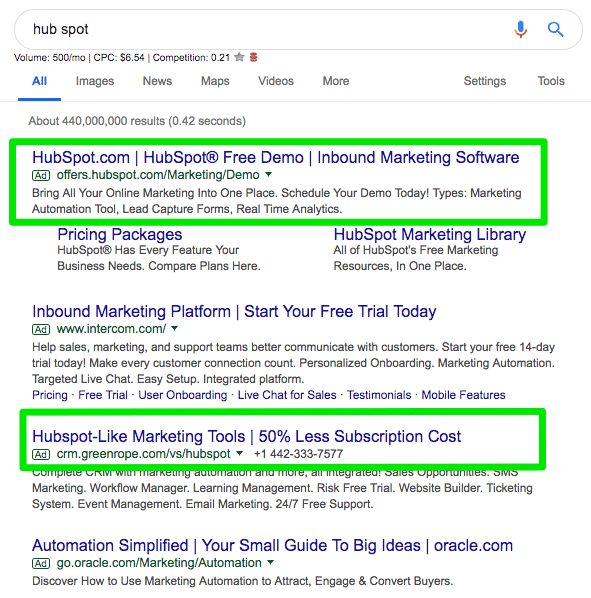The concept behind competitor targeting on AdWords is simple, and the practice can be highly effective when leveraged the right way.
By bidding on the branded terms of your competitors who offer similar products and services, you can appear for their branded terms in search results.
The main reason for doing so, is that by appearing for your competitors’ branded terms you can take potential traffic and clicks (and leads) from that particular competitor.
While this may seem like stealing, the competitor whose branded terms you’re appearing for isn’t paying a cent unless someone clicks on their ad.
And since the potential customer is conducting a brand-aware search, they’re much more likely to click on your competitor’s ad than yours — so why bother?
For starters, AdWords competitor targeting isn’t only about getting traffic, clicks and leads that could have gone to your competitors. Though that is, ultimately, the main goal, whether directly or indirectly.
It’s also about increasing awareness of your brand (for free) among an audience that’s looking for products and services like yours and are ‘brand-aware’ of the competitor you’re targeting.
When competitor targeting on AdWords is done right, it’s a win-win situation that will make you wonder why you hadn’t got around to it earlier.
You either get a click — one that went to you and not your competitor — or you receive increased brand awareness among your target market and the competition picks up the tab.
A legit way to get the lion’s share of traffic, leads and sales
AdWords competitor targeting is a widespread practice and it’s perfectly legal, provided that you follow Google’s rules. And as it’s Google, you don’t want to break the rules ever, as the consequences are just too severe.
To avoid incurring the wrath of Google, there are a few rules that you absolutely must not break, starting with deliberately using your competitors’ brand names in your ad copy or accidentally using their brand names via Dynamic Keyword Insertions (DKI) in your ads.

A good example of what not to do with AdWords competitor targeting. While legit, this is pushing the boundaries of what is and isn’t acceptable.
Not only would you quickly squander your budget, but you’d also annoy potential customers, really aggravate your competitors — something you don’t want to do, especially they have a bigger budget — and even put your business at risk of legal action.
You should also familiarise yourself with Google’s rules concerning Trademarks and make sure your own business brand is trademarked and protected.
Set up your AdWords campaign for success
To avoid a negative outcome, set up your AdWords campaign the right way.
Start by creating a separate campaign that targets your competitors and use their brand names as negative keywords in any related campaigns.
To identify which of your competitors’ branded terms are delivering results, create a dedicated AdGroup for each competitor you target.
And if you’re new to AdWords competitor targeting, it’s also a wise move to create a separate budget for your competitors’ campaigns to mitigate the risk of overspending.
Get a competitive advantage by writing great ads
Writing great ads is also essential if you’re to gain a competitive advantage over your targeted competitor.
The potential customer you’re targeting has brand awareness of your competitor, which means if you’re to entice them to click your ad, you have to give them a really good reason to do so.
And even if they don’t click your ad, as the second prize to successful AdWords competitor targeting is increasing awareness of your brand, you want to make the right impression.
Creating a value proposition that your competitor hasn’t addressed in their ads is a good way to get them to click your ad over theirs. Study your competitors’ ads and look for ways to address customers’ pain points and present your business as the best solution to their problem.
If your competitor isn’t using link extensions, look for ways to leverage dynamic ad extensions to make your ads more appealing than the competitions’. Extensions are an eye-catching way to draw users’ attention to your ads.
Beating them on pricing or discounts is another tactic worth considering, especially seeing that it’s one of the most important criteria among customers.
Monitor campaign performance and tweak
As with any AdWords campaign, you should keep a close eye on conversions with your competitor targeted campaigns.
If you’re not seeing results, tweak the campaign by rewriting/optimising your ads or lowering your bids.
You may find that you need to pause an AdGroup that isn’t delivering and look for a reason why it isn’t delivering.
For instance, searchers on mobile devices may be looking for your competitors’ address or phone number rather than researching products and services.
This is one of the many insights that you can gain through Google Analytics.
To wrap things up, AdWords competitor targeting is a highly effective way to appear for your competitors’ branded search terms and generate traffic.
And while there are risks involved, these can be mitigated when you follow the rules and look for legit ways to capitalise on the brand awareness they’ve generated.
Not sure why you’re not getting maximum value from your current Google AdWords campaign? Get your free AdWords report here and find out why.
Image Credit — rawpixel
Image Credit — Micaela Parente
Bambrick Media is a digital marketing agency based in Brisbane and providing a full suite of digital marketing solutions to local, interstate and national clients. Along with Google AdWords, we also offer Social Media Marketing, Search Engine Optimisation, Website Design and Conversion Rate Optimisation.